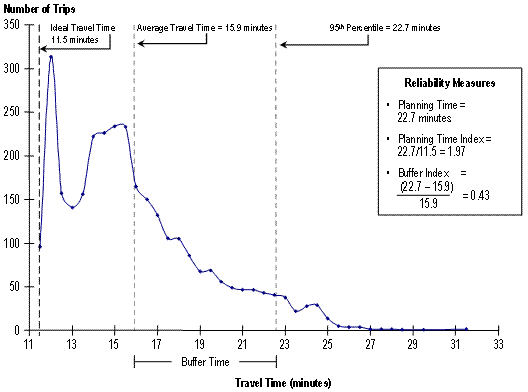|
|
|
final report
Traffic Congestion and Reliability:
Trends and Advanced Strategies for Congestion Mitigation
2.0 The Nature of Traffic Congestion and Reliability: Causes, How They Are Measured, and Why They Matter
2.1 WHAT IS CONGESTION?
Congestion is relatively easy to recognize—roads filled with cars, trucks, and buses, sidewalks filled with pedestrians. The definitions of the term congestion mention such words as "clog," "impede," and "excessive fullness." For anyone who has ever sat in congested traffic, those words should sound familiar. In the transportation realm, congestion usually relates to an excess of vehicles on a portion of roadway at a particular time resulting in speeds that are slower—sometimes much slower—than normal or "free flow" speeds. Congestion often means stopped or stop-and-go traffic. The rest of this chapter is devoted to describing congestion and how we measure it, as well as its causes and consequences.
2.2 CAUSES OF CONGESTION AND UNRELIABLE TRAVEL
2.2.1 Background: The Seven Sources of Congestion
Previous work has shown that congestion is the result of seven root causes, often interacting with one another.5 These "seven sources" can be grouped into three broad categories, as shown below:
Category 1 — Traffic-Influencing Events
- Traffic Incidents – Are events that disrupt the normal flow of traffic, usually by physical impedance in the travel lanes. Events such as vehicular crashes, breakdowns, and debris in travel lanes are the most common form of incidents. In addition to blocking travel lanes physically, events that occur on the shoulder or roadside can also influence traffic flow by distracting drivers, leading to changes in driver behavior and ultimately degrading the quality of traffic flow. Even incidents off of the roadway (a fire in a building next to a highway) can be considered traffic incidents if they affect travel in the travel lanes.
- Work Zones – Are construction activities on the roadway that result in physical changes to the highway environment. These changes may include a reduction in the number or width of travel lanes, lane "shifts," lane diversions, reduction, or elimination of shoulders, and even temporary roadway closures. Delays caused by work zones have been cited by travelers as one of the most frustrating conditions they encounter on trips.
- Weather – Environmental conditions can lead to changes in driver behavior that affect traffic flow. Due to reduced visibility, drivers will usually lower their speeds and increase their headways when precipitation, bright sunlight on the horizon, fog, or smoke are present. Wet, snowy, or icy roadway surface conditions will also lead to the same effect even after precipitation has ended.
Category 2 — Traffic Demand
- Fluctuations in Normal Traffic – Day-to-day variability in demand leads to some days with higher traffic volumes than others. Varying demand volumes superimposed on a system with fixed capacity also results in variable (i.e., unreliable) travel times, even without any Category 1 events occurring.
- Special Events – Are a special case of demand fluctuations where traffic flow in the vicinity of the event will be radically different from "typical" patterns. Special events occasionally cause "surges" in traffic demand that overwhelm the system.
Category 3 — Physical Highway Features
- Traffic Control Devices – Intermittent disruption of traffic flow by control devices such as railroad grade crossings and poorly timed signals also contribute to congestion and travel time variability.
- Physical Bottlenecks ("Capacity") – Transportation engineers have long studied and addressed the physical capacity of roadways—the maximum amount of traffic capable of being handled by a given highway section. Capacity is determined by a number of factors: the number and width of lanes and shoulders; merge areas at interchanges; and roadway alignment (grades and curves). Toll booths may also be thought of as a special case of bottlenecks because they restrict the physical flow of traffic. There is also a wild card in the mix of what determines capacity—driver behavior. Research has shown that drivers familiar with routinely congested roadways space themselves closer together than drivers on less congested roadways. This leads to an increase in the amount of traffic that can be handled.
Highlight Box 1 discusses how the seven sources of congestion are related to the underlying traffic flow characteristics that create a disruption in traffic. We typically think of a bottleneck as a physical restriction on capacity (Category 3 above). However, disorderly vehicle maneuvers caused by events have a similar effect on traffic flow as restricted physical capacity.
Because the traffic flow effects are similar, traffic disruptions of all types can be thought of as producing losses in highway capacity, at least temporarily. In the past, the primary focus of congestion responses was oriented to adding more physical capacity: changing highway alignment, adding more lanes (including turning lanes at signals), and improving merging and weaving areas at interchanges. But addressing the "temporary losses in capacity" from other sources is equally important.
Highlight Box 1 – What Causes Breakdowns in Traffic Flow? What causes traffic flow to break down to stop-and-go conditions? The layman's definition of congestion as "too many cars trying to use a highway at the same time" is essentially correct. Transportation engineers formalize this idea as capacity—the ability to move vehicles past a point over a given span of time. When the capacity of a highway section is exceeded, traffic flow breaks down, speeds drop, and vehicles crowd together. These actions cause traffic to back up behind the disruption. So, what situations would cause the overload that leads to traffic backups? Basically, there are three types of traffic flow behavior that will cause traffic flow to break down:
Influencing all of these disruptions in traffic flow is the level of traffic that attempts to use the roadway. High demand for highway use—such as that caused by special events—can compound the problems caused by disruptions to traffic flow. |
2.2.2 How the Seven Sources Cause Congestion
Congestion results from one—or the interaction of several—of the seven sources on the highway system. The interaction can be complex and varies greatly from day-to-day and highway-to-highway. The problem is that with the exception of the physical bottlenecks, the sources of congestion occur with maddening irregularity—nothing is ever the same from one day to the next! One day commuters might face low traffic volumes, no traffic incidents, and good weather; the next day traffic might be heavier than normal, it might be raining, and a severe crash may occur that blocks traffic lanes. An analysis of how the combination of these events conspires to make congestion was done in Washington, D.C. (Table 2.1). The worst traffic days experienced in Washington can be explained by the occurrence and combination of different events.
Another example of the irregularity in event occurrence can be seen in the frequency and duration of traffic incidents. Figure 2.1 shows how traffic incidents occurred on a 14-mile stretch of Interstate 405 in Seattle, Washington during peak travel periods for the first four months of 2003. Some days are relatively incident-free while others have numerous traffic incidents. Interestingly, at least one traffic incident occurred every day during the peaks on this highway. So, while some days are better than others, traffic incidents are an unavoidable fact on crowded urban freeways.
Another source of variability is traffic demand, which is rarely the same from day-to-day. On routes heavily used for commuting, weekday traffic is typically much higher than weekend traffic. (On routes in recreational, tourist, or shopping-dominated areas, weekend traffic higher.) Figure 2.2 shows this variability in dramatic fashion for Detroit freeways. It also shows that there is some variability on weekdays: Thursdays and Fridays are typically the highest traffic days for this period.
The congestion and travel time variability caused by planned special events are becoming a major concern for transportation agencies. In a recent survey of state Departments of Transportation (DOTs) by the American Association of State Highway and Transportation Officials and the American Highway Users Alliance, special events were cited as significant contributors to noncommuter congestion. These events may be categorized as:
- Major Sporting Events – This includes sports events within cities (e.g., major league baseball, professional football games) and college sporting events in relatively small university towns, especially college football. In fact, many college football games are attended by 100,000 spectators or more, and the associated congestion in towns and small cities (e.g., Ann Arbor, Michigan; Knoxville, Tennessee; and Lincoln, Nebraska) can overwhelm the local highway system on game days. The only saving grace is that usually there are no more than seven home games per year; nonetheless, congestion is significant on these days, requiring a lot of planning and active management by transportation and enforcement personnel.
Table 2.1 Factors Contributing to Extreme Congestion
Ten Worst Days of Washington, D.C. Traffic
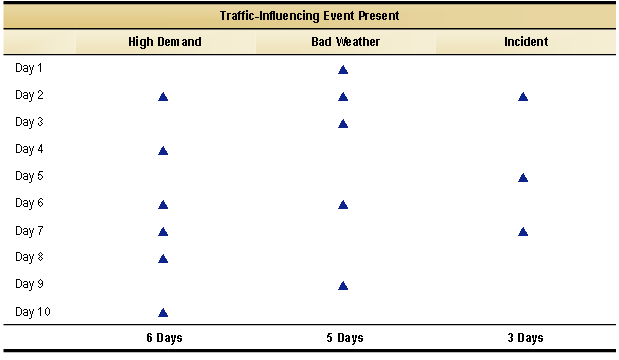
Source: Vasudevan, Meenakshy; Wunderlich, Karl E., Shah, Vaisshali; and Larkin, James, Effectiveness of Advanced Traveler Information Systems (ATIS) Under Extreme Congestion: Findings from a Washington, D.C., Case Study, proceedings of ITS America, 2004.
The events that impede traffic flow and cause travel to be unreliable often occur in combination. This diagram shows the number of days when different combinations of events occurred during the study period. For example, there were three days when incidents occurred—on two of these days only incidents occurred and on one day, incidents occurred in combination with high demand and bad weather. As most commuters know, "some days are worse than others." Pile high demand (say, a Friday before a three-day weekend) on top of heavy rain and a lane-blocking crash, and you've got the ingredients for severe congestion.
Figure 2.1 The Number and Duration of Incidents Varies Greatly from
Day to Day
I-405 Southbound, Seattle, Washington
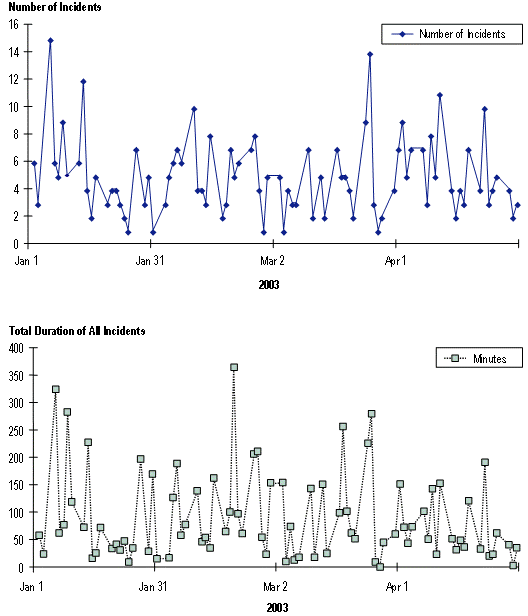
Note: Data shown are for the morning and afternoon peak periods (7:00-10:00 a.m. and 4:00-7:00 p.m.) for the period from January 1, 2003 to April 30, 2003. Traffic incidents occur in a fairly erratic pattern from day-to-day. Also, how long they last and how many lanes they block are fairly unpredictable. This erratic behavior contributes significantly to making travel unreliable for travelers.
Figure 2.2 Traffic Levels Vary Substantially over the Course of a Week
Detroit Freeways, 3/11/2001 - 4/7/2001
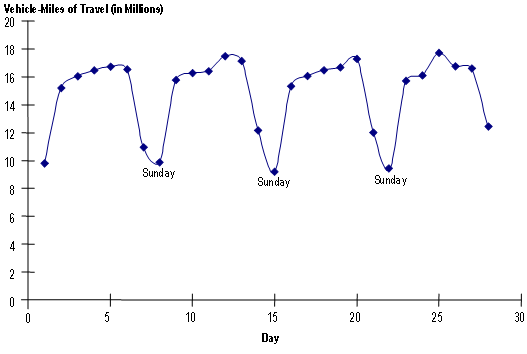
Note: VMT (or "vehicle-miles of travel") is a common measure of highway usage. It is calculated as the number of vehicles using the system times the distance they travel. For the time period displayed, Sundays are the low points on the graph. Weekday travel can be more than 60 percent higher than Sunday travel. On weekdays, the trend toward highway travel later in the week (Thursdays and Fridays) is common in most urban areas. While commuting trips are relatively stable throughout the week, discretionary trips are higher as the weekend approaches.
- Auto and Horse Races – The rise in the popularity of NASCAR has led to increased congestion around race events.
- University "Move-in Day" – Several DOTs indicated that the start of fall term on college campuses create a surge in traffic for two to three days. This seems to be a problem in the smaller towns and cities with large universities, where the local highway network is not well suited to handling large volumes during off-peak periods.
- Festivals, State Fairs, and Major Concerts – Many rural areas sponsor these types of events lasting one or more weekends throughout the year. For example, the Bonaroo pop music festival in central Tennessee draws close to 100,000 people one weekend per year. These festival-goers cram onto highways not meant for such traffic, and many arrive several days early and stay a few days late.
- Seasonal Shopping – Holiday shopping around major mall areas was indicated as another source of noncommuting congestion, particularly on weekends between Thanksgiving and Christmas.
As if the congestion picture was not complicated enough, consider further that some events can cause others to occur. For example:
- The presence of severe congestion can reduce demand by shifting traffic to other highways or cause travelers to leave later. High congestion levels can also lead to an increase in traffic incidents due to closer vehicle spacing and overheating of vehicles during summer months.
- Bad weather can lead to crashes due to poor visibility and slippery road surfaces.
- The traffic turbulence and distraction to drivers caused by an initial crash can lead to other crashes.6 They can also lead to overheating, running out of gas and other mechanical failures resulting from begin stuck behind another incident.
All of this suggests the rather complex model of congestion shown in Figures 2.3a and 2.3b. From a practical standpoint, what is important to take away from this model are two notions: 1) the sources of congestion can be tightly interconnected, and 2) because of the interconnectedness, significant payoffs can be expected by treating the sources. That is, by treating one source, you can reduce the impact of that source on congestion plus have a partial impact on others.
The exact causal relationships among the sources of congestion are not yet well known, but consider the data shown in Figure 2.4. Displayed in this figure is the relationship between delay (both bottleneck- and incident-related) and traffic intensity. Several observations can be made from these data:
- For a roadway with fixed physical capacity, traffic must build sufficiently before either bottleneck delay or traffic incident delay occurs. That this is the case for bottleneck delay is obvious. However, for traffic incidents it does show that at low congestion levels, enough excess capacity exists to absorb the effect of most traffic incidents. (During the course of time, a few traffic incidents will block all traffic lanes causing substantial delay, but over a long history, these effects are washed out.)
- At the traffic intensity level where congestion begins (AADT7-to-capacity ratio range of 8 to 10), incident-related congestion is a substantial part of total congestion. As the traffic grows on a roadway with fixed capacity, bottleneck-related congestion becomes increasingly dominant.
Figure 2.3 Anatomy of Congestion
Figure 2.3a Part 1 - Traffic Volumes Interact with Physical Capacity to Produce "Base Delay"
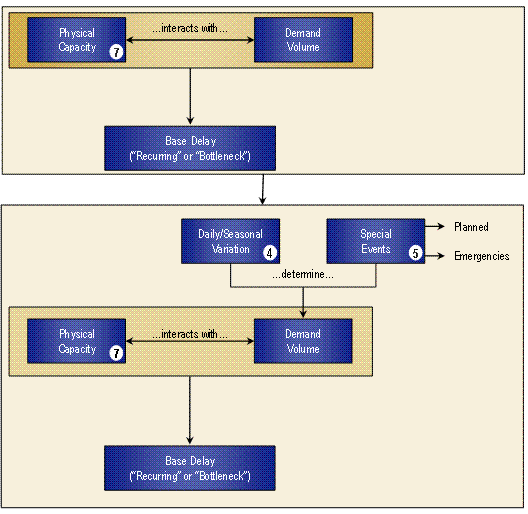
![]() = Source of Congestion
= Source of Congestion
Note: The starting point for congestion on most days is the amount of traffic and the physical restrictions on the highway (bottlenecks). Traffic varies from day-to-day throughout the year and special events may cause surges in traffic at unexpected times. See Figure 2.2 as an example of how much traffic varies even over as short a period as a month.
Figure 2.3 Anatomy of Congestion (continued)
Figure 2.3b Part 2 - Roadway Events Reduce Available Capacity and Add Extra Delay to the System
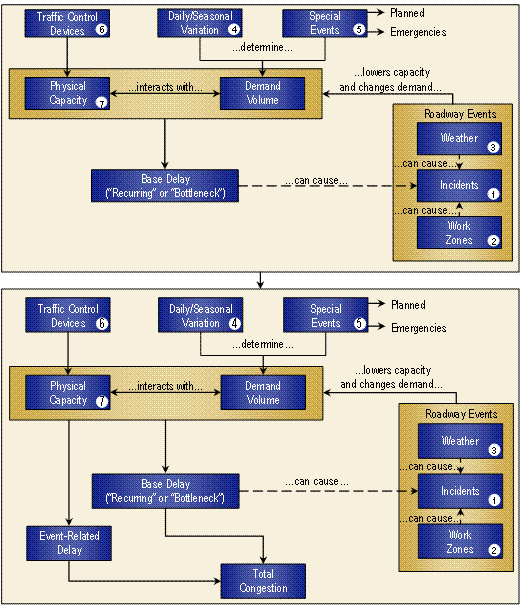
![]() = Source of Congestion
= Source of Congestion
Note: Just as traffic varies across time periods, so does physical capacity. The operation of traffic signals changes capacity, often minute-to-minute. When roadway events occur, they also cause the physical capacity of the roadway to be lowered. (Traffic incidents and work zones can "steal" lanes, and bad weather causes drivers to space themselves out more.) Base-level congestion caused by bottlenecks can lead to increased traffic incidents due to tighter vehicle spacing and vehicles overheating in summer. Finally, the existence of extreme congestion can cause some drivers to change their routes or to forego trips altogether. Understanding how all these factors interact is the subject of ongoing research.
Figure 2.4 Relationship of Incident and Bottleneck Delay to Traffic Intensity
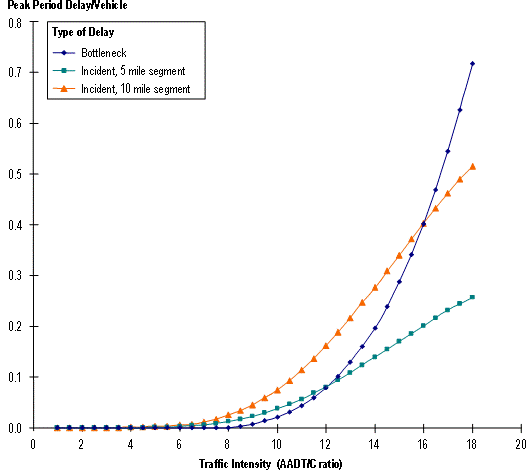
Note: The AADT/C level is a general indicator of the "intensity" of traffic trying to use a highway with fixed capacity. AADT is Annual Average Daily Traffic (vehicles per day) and C is the two-way capacity of the roadway (vehicles per hour). Bottleneck and traffic incident delay occur differently: bottlenecks cause delay at specific points while traffic incidents may occur anywhere along a highway segment. This is the reason for using 5- and 10-mile segments for the traffic incident delay above. The analysis shows that as traffic grows on a roadway with fixed capacity, traffic incident delay is initially higher than bottleneck delay. As traffic grows, bottleneck delay overtakes traffic incident delay, because it happens fairly regularly while traffic incidents vary in occurrence and characteristics.
This analysis also shows the interrelationship between the sources of delay identified in Figures 2.3a and 2.3b. Even with no changes in traffic incident characteristics, traffic incident delay grows as more traffic is added to a roadway. In other words, as the traffic level grows on a base of fixed capacity, the roadway is more vulnerable to disruptions caused by traffic incidents, or any other traffic-influencing event for that matter.
The exponential growth in bottleneck delay after the onset of congestion is a major reason why it is so difficult for agencies to keep up with congestion: once it starts, things get bad quickly. Introducing an extra vehicle to congested conditions means not only does that vehicle get delayed, it also adds extra delay to any other vehicles that join after it.
- At higher base congestion levels, bottleneck-related congestion grows at an increasingly faster rate. Researchers have long noted that delay increases exponentially (i.e., it goes "ballistic") with traffic level on a fixed capacity base. Why is this? Once a queue has formed and an additional vehicle joins at the back of the queue, you get a double whammy: not only is that vehicle delayed, but the queue is now longer and any new vehicles that join in will also be delayed by the now longer queue. The growth in delay for traffic incidents is more of a straight line, the results of the irregular occurrence of traffic incidents—they do not happen consistently like bottleneck delay does.
The fact that both bottleneck- and incident-related delay increase with base congestion level indicates that if physical capacity is increased, congestion for both sources would be decreased. In other words, Facilities with greater base capacity are less vulnerable to disruptions: a traffic incident that blocks a single lane has a greater impact on a highway with two travel lanes than a highway with three travel lanes. This feature highlights the interdependence of the sources mentioned above. It also reinforces the notion that adding physical capacity is a viable option for improving congestion, especially when made in conjunction with other strategies.
2.2.3 The Reliability of Travel Time and Why It Matters
What Is Travel Time Reliability? By its very nature, roadway performance is at the same time consistent and repetitive, and yet highly variable and unpredictable. It is consistent and repetitive in that peak usage periods occur regularly and can be predicted with a high degree of reliability. (The relative size and timing of "rush hour" is well known in most communities.) At the same time, it is highly variable and unpredictable, in that on any given day, unusual circumstances such as crashes can dramatically change the performance of the roadway, affecting both travel speeds and throughput volumes.
The traveling public experiences these large performance swings, and their expectation or fear of unreliable traffic conditions affects both their view of roadway performance, and how and when they choose to travel. For example, if a road is known to have highly variable traffic conditions, a traveler using that road to catch an airplane routinely leaves lots of "extra" time to get to the airport. In other words, the "reliability" of this traveler's trip is directly related to the variability in the performance of the route she or he takes.
It is becoming clear that we can no longer just define congestion in terms of "average" or "typical" conditions. One of the reasons was identified in Figure 2.4—as the traffic on a fixed capacity roadway, a highway becomes more susceptible to delay from traffic incidents, and in fact, to all traffic-influencing events. Because reliability indicates how much events influence traffic conditions, it is particularly important when it comes to defining operations strategies, which aim to control the effect of these events.
With this discussion in mind, from a practical standpoint, travel time reliability can be defined in terms of how travel times vary over time (e.g., hour-to-hour, day-to-day). Commuters who take congested highways to and from work are well aware of this. When asked about their commutes, they will say things like: "it takes me 45 minutes on a good day, but an hour and 15 minutes on a bad day."
Figure 2.6 typifies this experience with data from State Route (SR) 520, a major commuter route, in Seattle, Washington. If there was no congestion on this 11.5 mile segment, travel times would be around 11 1/2 minutes; on President's Day this was the case. On other days, the average travel time was 17.5 minutes, or an average speed of 40 mph. But when events (traffic incidents and weather) are present, it could take nearly 25 minutes, or 37 percent longer. Commuters who take SR 520 corridor must plan for this unpredictable variability if they want to arrive on time—the average just will not do.
Figure 2.6 Weekday Travel Times
5:00-6:00 p.m., on State Route 520 Eastbound, Seattle, Washington

In other words, they have to build in a buffer to their trip planning to account for the variability. If they build in a buffer, they will arrive early on some days, which is not necessarily a bad thing, but the extra time is still carved out of their day. And this is time they could be using for other pursuits besides commuting.
What Value Does Providing Reliable Travel Times Have? Improving the reliability of travel times is significant for a number of reasons:
- Improvements in reliability are achieved by lessening the overall variability due to the seven sources of congestion, mainly traffic-influencing events. In other words, improvement strategies targeted at reliability decrease the delay due to traffic-influencing events (e.g., traffic incidents, bad weather, and work zones). This produces a double benefit: not only is variability reduced but the total congestion delay experienced by travelers is also reduced.
- Reducing total congestion saves time and fuel, and leads to decreased vehicle emissions.
- Reducing congestion at international border crossings leads to lower transportation costs and benefits the national economy as a whole. Further, reducing congestion on United States highways for freight moving between Canada and Mexico fosters international trade. Therefore, congestion on United States highways has a large influence on the efficiency of international trade.
- Treating three major components of unreliable travel—traffic incidents, bad weather, and work zones—also leads to safer highways. By reducing the duration of these events, we are reducing how long travelers are exposed to less safe conditions.
- Commuters as well as freight carriers and shippers are all concerned with travel time reliability. Variations in travel time can be highly frustrating and are valued highly by both groups. Previous research8 indicates that commuters value the variable component of their travel time between one and six times as much as average travel time. And the increase in just-in-time (JIT) manufacturing processes has made a reliable travel time extremely important. Significant variations in travel time will decrease the benefits that come from lower inventory space and the use of efficient transportation networks as "the new warehouse." Therefore, in both the passenger and freight realms, evidence suggests that travel time reliability is valued at a significant "premium" by users.
2.2.4 How Travelers, Operators, and Planners View Reliability
Despite our simple definition of travel time reliability as the variation in travel times over history, different perspectives exist:
- Travelers want to know information about the specific trip they are about to make and how it compares to their typical or expected trip;
- Similarly, operators want to know how the system is performing now in relation to typical conditions; and
- Planners want to know how the system performed last month or last year in comparison to previous time periods.
As we have already seen, some days are better (or worse) than others in terms of congestion, and there is quite a bit of variation from average or typical conditions on any given day. Figure 2.7 displays this variation from the traveler and operator points of view. Shown are travel times in the heavily congested I 75 corridor in central Atlanta for all Thursdays in 2003. The average and 95th percentile travel times are shown along with the actual travel times from two specific Thursdays. January 16 was clearly a "bad" day in this corridor while September 4 was "better than average." For both travelers and operators, a constantly updated display of travel conditions compared to baselines would be valuable information to have. In fact, at least one traffic management center (Houston TRANSTAR) posts this sort of information on their web site in real-time.9 It should be noted that currently we do not have the ability to predict what is going to happen—a difficult task given the uncertainty of unpredictable events like incidents or sudden, intense weather. We can only compare what is happening now to historical conditions, but research is currently underway on this topic.
Still, the ability to predict with some certainty what travel time will be in the near future is of great interest to operators and travelers. Why is this important? If a commuter has a routine activity that must occur every day—such as picking up children from day care—they must plan on an extra amount of trip time just to be sure they do not arrive late. The same goes for local trucking firms engaged in pickup and delivery of goods. Looking again at the data in Figure 2.7, if a traveler starts in the corridor at 5:30 p.m., on the average Thursday the trip will take about 12 minutes. But history has shown that to be safe, they have to plan for about 18 minutes (50 percent more) to have only a small chance of arriving late; they have to build in a buffer. These are not huge numbers—but this is a short corridor (4 miles). The difference is, however, a large percentage. If similar conditions exist over the rest of the commute, then the extra time starts to add up quickly. With this simple approach, an extreme event can cause great problems for an individual trip, but at least we can compute a reasonable probability of arriving on time.
Figure 2.7 Is It a Good Day or Bad Day for Commuting:
Comparing Current Travel Times to Historical Conditions
I-75 Southbound Central Atlanta, Thursdays, 2003
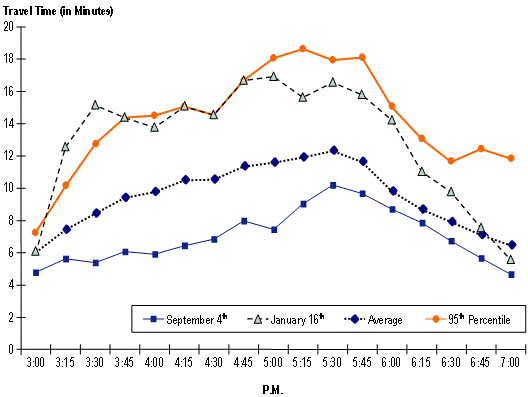
Note: Comparing what is happening on the highway system right now to "typical" (average) and "extreme" (95th percentile) conditions provides both operators and travelers with information that can lead to actions. For example, the afternoon of September 4, travelers could see that congestion was lighter than usual and could schedule additional activities. January 16 on the other hand was a heavy congestion day and as it unfolded, operators could post diversion messages to try to control it.
Planners are most interested in how things change over a longer period of time, though the question of "are things getting better or worse" is of general interest as well. In the I 75 corridor in central Atlanta, travel times in the afternoon peak period have increased and reliability has decreased between 2001 and 2003 (Figure 2.8). Monitoring of performance trends like this is becoming more common at transportation agencies. As discussed in the next section, performance monitoring is a major emphasis in operations and planning.
Figure 2.8 Congestion and Unreliable Travel Have Increased on
I-75 Southbound in Central Atlanta, Georgia
Thursdays, 2001 and 2003
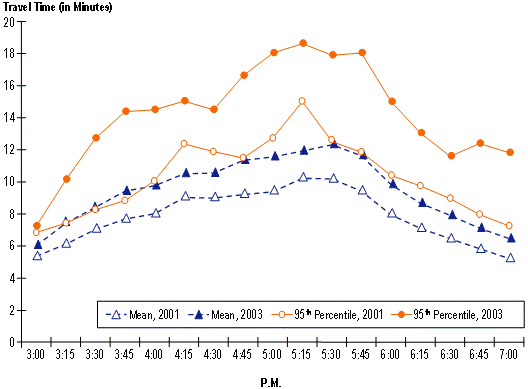
Note: By comparing the average travel times in 2001 and 2003 (the blue lines)), it can be seen that average congestion levels have increased in this corridor. At the same time, travel time reliability has decreased, as shown by the increase in the 95th percentile travel times.
2.3 TRACKING CONGESTION
2.3.1 Why Monitor Congestion?
Monitoring congestion is just one of the several aspects of transportation system performance that leads to more effective investment decisions for transportation improvements. Safety, physical condition, environmental quality, economic development, quality of life, and customer satisfaction are among the aspects of performance that also require monitoring.10 Congestion is intertwined with all of these other categories since higher congestion levels have been associated with their degradation.
In addition to facilitating better investments, improved monitoring of congestion can lead to several positive outcomes:
- Improved Performance –The information from operating systems can be used by the operating agencies to alter hours or methods of operation to improve the system. Performance measures can target, for example, before/ after effects of recent programs or the amount of productivity lost from congested conditions.
- Improved Communication – Performance measures that include travel time, delay, or other easily understood concepts can provide better ways to communicate system conditions.
- Program Justification – Performance measures and a before/after data collection program can be very effective at identifying the effect of a range of freeway and arterial management actions. Many of these actions cannot be easily assessed using models.
- Funding Enhancements – In most recent campaigns for funding increases, pricing projects or increased funding flexibility, performance measures have played two key roles. They can be used to demonstrate improved conditions or use of existing funds to show that current agency actions are appropriate and beneficial. The measures and data also can be used in public accountability pledges to demonstrate the effect of the proposed programs.
2.3.2 Congestion Performance Measures
Travel Time as the Basis for Congestion Performance Measures
The performance of the highway system in terms of how efficiently users can traverse it may be described in three basic terms: congestion, mobility, and accessibility. While researchers have different definitions of these terms, we have found it useful to define them as follows:
- Congestion – Describes the travel conditions on facilities;
- Mobility – Describes how well users can complete entire trips; and
- Accessibility – Describes how close opportunities (e.g., jobs, shopping) are spaced in terms of the user's ability to access them through the transportation system.
Congestion and mobility are very closely related and the same metrics and concepts can be used to monitor both. Accessibility is a relatively new concept and requires a different set of metrics. Most the data that are currently available describe facility performance, not trip performance, although new technologies are emerging that will allow for direct monitoring of entire trips.
One of the principles that FHWA has established for monitoring congestion as part of its annual performance plan is that meaningful congestion performance measures must be based on the measurement of travel time. Travel times are easily understood by practitioners and the public, and are applicable to both the user and facility perspectives of performance.
Temporal Aspects of Congestion: Measuring congestion by times of the day and day of week has a long history in transportation. A relatively new twist on this is the definition of a weekday "peak period"—multiple hours rather than the traditional peak hour. In many metropolitan areas, particularly the larger ones, congestion now lasts three or more hours each weekday morning and evening. In other words, over time, congestion has spread into more hours of the day as commuters leave earlier or later to avoid the traditional rush hour. Definition of peak periods is critical in performing comparisons. For example, consider a three-hour peak period. In smaller cities, congestion may usually only last for one hour—better conditions in the remaining two hours will "dilute" the metrics. One way around this is not to establish a fixed time period in which to measure congestion, but rather determine how long congestion exists (e.g., percent of time where operating conditions are below a threshold.)
Spatial Aspects of Congestion: Congestion spreads not only in time but in space as well. Queues from physical bottlenecks and major traffic-influencing events (like traffic incidents) can extend for many miles. Congestion measures need to be sensitive to this by tracking congestion over facilities or corridors, rather than just short highway segments.
Table 2.2 presents a small sample of congestion performance measures (metrics) that can be used by agencies to monitor trends.
| Performance Metric | Definition/Comments |
|---|---|
| Throughput | |
| Vehicle-Miles of Travel Truck Vehicle-Miles of Travel Person-Miles of Travel |
Vehicle-miles of travel are the number of vehicles on the system times the length of highway they travel. Person-miles of travel is used to adjust for the fact that some vehicles carry more than a driver. |
| Average Congestion Conditions | |
| Average Travel Speed | The average speed of vehicles measured between two points. |
| Travel Time | The time it takes for vehicles to travel between two points. Both travel time and average travel speed are good measures for specific trips or within a corridor. |
| Number and percent of trips with travel times > (1.5 * average travel time) Number and percent of trips with travel times > (2.0 * average travel time) |
Thresholds of 1.5 and 2.0 times the average may be adjusted to local conditions; additional thresholds may also be defined. |
| Travel Time Index | Ratio of actual travel time to an ideal (free-flow) travel time. Free-flow conditions on freeways are travel times at a speed of 60 mph. |
| Total Delay (vehicle-hours and person-hours) Bottleneck ("Recurring") Delay (vehicle-hours) Traffic incident Delay (vehicle-hours) Work Zone Delay (vehicle-hours) Weather Delay (vehicle-hours) Ramp delay (vehicle-hours and person-hours; where ramp metering exists) Delay per Person Delay per Vehicle |
Delay is the number of hours spent in traffic beyond what would normally occur if travel could be done at the ideal speed. Determining delay by "source of congestion" requires detailed information on the nature and extent of events (incidents, weather, and work zones) as well as measured travel conditions. Delay per person and delay per vehicle require knowledge of how many vehicles and persons are using the roadway. |
| Percent of VMT with Average Speeds < 45 mph Percent of VMT with Average Speeds < 30 mph |
VMT is vehicle-miles of travel, a common measure of highway usage. |
| Percent of Day with Average Speeds < 45 mph Percent of Day with Average Speeds < 30 mph |
These measures capture the duration of congestion. |
| Reliability | |
| Planning Time (computed for actual travel time and the Travel Time Index) | The 95th percentile of a distribution is the number above which only 5 percent of the total distribution remains. That is, only 5 percent of the observations exceed the 95th percentile. For commuters, this means that for 19 out of 20 workdays in a month, their trips will take no more than the Planning Time. |
| Planning Time Index (computed for actual travel time and the Travel Time Index) | Ratio of the 95th percentile ("Planning Time") to the "ideal" or "free flow" travel time (the travel time that occurs when very light traffic is present, about 60 mph on most freeways). |
| Buffer Index | Represents the extra time (buffer) most travelers add to their average travel time when planning trips. |
For a specific road section and time period: Buffer Index (%) = |
95th percentile travel time (minutes) - average travel time (minutes) average travel time (minutes) |
2.3.3 Methods Used to Develop Congestion Performance Measures
Figure 2.9 shows how travel times can be developed from data, analytic methods, or a combination. Clearly, the best methods are based on direct measurement of travel times, either through probe vehicles or the more traditional "floating car" method, in which data collectors drive specific routes. However, both of these have drawbacks: probe vehicles currently are not widely deployed and the floating car method suffers from extremely small samples because it is expensive and time consuming. Further, since many performance measures require traffic volumes as well, additional collection effort is required to develop the full suite of performance measures. Use of ITS roadway equipment addresses these issues, but this equipment does not measure travel time directly; ITS spot speeds must be converted to travel times first. (The Appendix provides a description of the equipment used to collect these data.) Other indirect methods of travel time estimation use traffic volumes as a basis, either those that are directly measured or developed with travel demand forecasting models. Two examples of how FHWA is developing travel times with these methods follow.
Figure 2.9 Measuring Travel Time Is the Basis for Congestion Measures
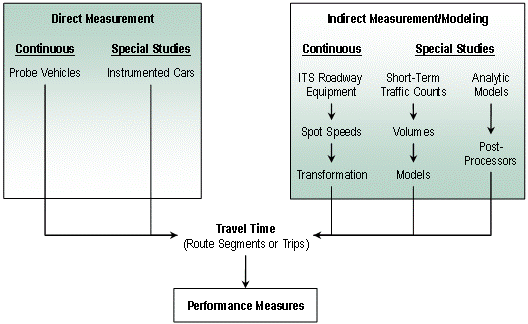
Monthly Urban Congestion Report
Since 2000, FHWA has been assembling volume and speed data from urban traffic management centers. These data are primarily from ITS roadway equipment, although some cities are exploring the use of probe vehicles to capture travel time. Data from 29 cities are currently obtained annually from participating traffic management centers. Some of these cities are now providing data on a monthly basis, and these monthly data are used to track citywide trends month-by-month. Figure 2.10 shows an example of how these data are presented. As more cities participate—and as surveillance coverage increases in existing cities—these data will provide a way for FHWA to monitor monthly changes in congestion. (Section 3.0 presents additional analysis of the data used in this program.)
Figure 2.10 Example of the Newly Designed Urban Congestion Report
Used by FHWA to Track Monthly Changes in Congestion
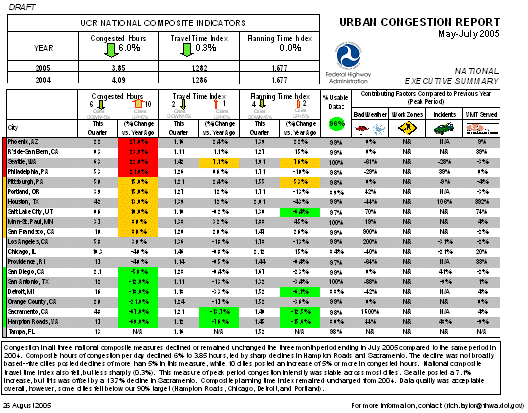
Freight Performance Measurement Initiative
The tracking of congestion within cities is dependent on having an intensive system of surveillance to collect vehicle speeds (through roadway detectors) or travel times (using toll-tagged probe vehicles) at closely spaced points on the roadway. Outside of major metropolitan areas, such surveillance does not exist. To complement urban congestion measures and get a better picture of total system performance, FHWA is developing a system to monitor truck travel on intercity corridors that have significant freight volumes. FHWA is partnering with the American Transportation Research Institute and the trucking industry to use existing satellite-based systems that track truck movement for freight and fleet management purposes to support transport system performance measurement. Additionally, FHWA is exploring using similar methods to measure delay at major international border crossings. Figure 2.11 shows an example of how this system has been applied to develop travel times on 10-mile stretches of Interstate 5.
Figure 2.11 Interstate 5 Average Travel Rate for Trucks: 10-Mile Segments
April-June 2004, 3:00-7:00 p.m.
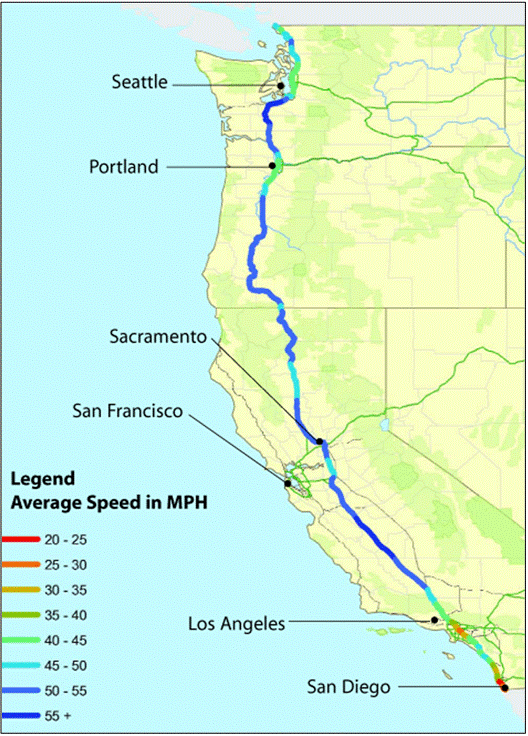
2.4 CONGESTION'S CONSEQUENCES
The nation's local, regional, and national transportation systems play a vital role in creating access to goods and services which sustain and grow our nation's economy. Planners and economic development experts recognize that congestion is an economic development issue because it thwarts business attraction and expansion, and reduces the quality of life for residents.
Transportation system users have developed strategies to deal with increased congestion and reduced reliability. In the short term, we might change our mode or time of travel. Over the longer run, congestion might influence our decisions about where we live and work. The same holds true for businesses. These types of adjustments might reduce the impacts of congestion to us, but they still do not entirely eliminate the economic consequences for a region.
Trucking Impacts. Congestion means longer travel times and less reliable pick-up and delivery times for truck operators. To compensate, motor carriers typically add vehicles and drivers and extend their hours of operation, eventually passing the extra costs along to shippers and consumers. Research on the trucking industry has shown that shippers and carriers value transit time in the range of $25 to $200 per hour, depending on the product being carried. The cost of unexpected delay can add another 20 percent to 250 percent.11
Impacts on Businesses. Congestion increases the costs of delivering goods and services, because of the increased travel times and operating costs incurred on the transportation system. Less obviously, there may be are other costs, such as:
- The costs of remaining open for longer hours to process late deliveries;
- Penalties or lost business revenue associated with missed schedules;
- Costs of spoilage for time-sensitive, perishable deliveries;
- Costs of maintaining greater inventory to cover the undependability of deliveries;
- Costs of reverting to less efficient production scheduling processes; and
- The additional costs incurred because of access to reduced markets for labor, customer, and delivery areas.
The business value of time delay and market access act together to affect the profitability and revenue potential associated with doing business in a state or region. When one area is affected by congestion more than others, the relative competitiveness of these areas also shifts. The result, then, is that businesses tend to stagnate or move out of areas with high operating costs and limited markets, while they locate and expand in areas with lower operating costs and broader market connections. The magnitude of these changes varies by industry, based on how strongly the industry's total operating cost is affected by transportation factors. The evidence seems to indicate that regional economies that are fostered by clusters or "agglomerations" of many interrelated firms are better positioned to counter the higher operating costs due to congestion than economies that are not.
Household Impacts. Households have both financial budgets and what is termed "time budgets" that are both impacted by congestion. Households plan their activities around the available time budget as well as around their financial budgets. As vehicle operating and maintenance costs increase with rising congestion, the budget for some types of activities or expenditures decreases. The perceived "quality of life" of a neighborhood is diminished as well, when the safety, reliability and the convenience of the transportation system decreases.
Regional Impacts. Regional economies are affected by these household and business-specific impacts. Diminished cost competitiveness and market growth opportunities are tantamount to a reduced ability to retain, grow, and attract businesses. Additionally, the redistribution of business and household activity to outlying areas and the direct delay for trips that are not diverted or otherwise changed both lead to decreases in air quality, increases in public infrastructure investment requirements, and potential impacts on health and quality of life factors.12
- Providing a Highway System with Reliable Travel Times, Future Strategic Highway Research Plan Area 3, Transportation Research Board, September 2003, http://www4.trb.org/ trb/newshrp.nsf/web/progress_reports?OpenDocument.
- This phenomenon is sometimes referred to as "secondary crashes"—crashes that would not have occurred unless an earlier one in close proximity occurred. Possible causes of secondary crashes include rapidly growing queues caused by the first crash and rubbernecking by motorists.
- Average Annual Daily Traffic – the amount of traffic that moves on the average day. Computed as simple average of all 24-hour traffic throughout the year. The AADT-to-capacity ratio is similar to the volume-to-capacity used in many transportation analyses, except the former uses 24-hour total traffic while the later uses hourly traffic.
- Cohen, Harry, and Southworth, Frank, On the Measurement and Valuation of Travel Time Variability Due to Incidents on Freeways, Journal of Transportation Statistics, Volume 2, Number 2, December 1999, http://www.bts.gov/jts/V2N2/vol2_n2_toc.html.
- http://traffic.houstontranstar.org/layers/.
- More detail on monitoring comprehensive transportation system performance may be found in: A Guidebook for Performance-Based Transportation Planning, NCHRP Report 446, Transportation Research Board, Washington, D.C., 2000.
- Federal Highway Administration, Freight Transportation: Improvements and the Economy; https://ops.fhwa.dot.gov/freight/freight_analysis/improve_econ/.
- Weisbrod, Glen, Vary, Don, and Treyz, George, Economic Implications of Congestion, NCHRP Report 463, Transportation research Board, 2001.
Previous | Table of Contents | Next
